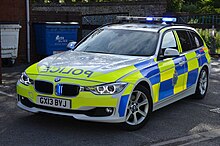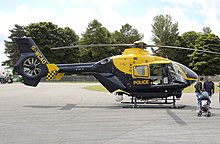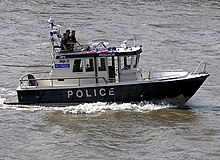Police vehicles in the United Kingdom
This article needs additional citations for verification. (April 2009) |
The 48 police forces in the UK use a wide range of operational vehicles including compact cars, powerful estates and armored police carriers. The main uses are patrol, response, tactical pursuit and public order policing. Other vehicles used by British police include motorcycles, aircraft and boats.

Incident response vehicles

.
Incident response vehicles (IRVs) are used by police forces to respond to emergencies quickly and to conduct patrols. They are fitted with blue lights and sirens to enable the vehicle to warn other vehicles of its presence. Most forces use the Vauxhall Astra or Ford Focus as IRVs. However, Peugeot 308s are now becoming a popular choice by UK police forces, due to their comparatively lower cost to other suitable previously preferred vehicles.
Engine sizes vary according to each forces vehicle procurement policies but range from 1.3 to 2.0. Although petrol-powered engines once dominated, diesel engines are now becoming much more common due to their superior fuel economy, and therefore lower operating costs. As well as this, both partially and fully electric models are also having an increasing presence for use as police vehicles.
Marked variants of these cars typically feature a single row of battenburg police markings on each side of car with 'Police' lettering on the front and rear of the vehicle. Force badges or slogans can sometimes be found on the front and sides of marked cars in most areas. Most marked cars also have high-visibility chevrons on the back.
IRVs will generally carry equipment and lighting for use at traffic incidents, such as traffic cones, warning signs and basic first aid equipment. Many response cars in the UK now also carry mobile technology which can be linked to police databases and automatic number plate recognition technology.
Roads policing

Road policing units, more informally known as traffic cars, are faster police vehicles used by specialist officers, tasked with conducting high speed pursuits and responding to major traffic accidents. Traffic cars are often estate cars or SUVs that can carry additional equipment, such as traffic cones, signs to warn of road closures or collisions and some basic scene preservation equipment. Their daily roles primarily consist of ANPR patrols.
The most common traffic cars include the BMW 3 Series, the BMW 5 Series, the BMW X5s, the Land Rover Discovery and the Volvo V70.
A variety of unmarked vehicles is commonly used in the traffic car role.
Area cars
Area cars are used to act as a bridge between IRVs and the Roads Policing Unit. Area cars carry battenburg markings like all other marked police vehicles. Area car drivers are trained in advanced driving with initial and advanced phased pursuit. Area cars generally higher performance vehicles such as the BMW 5 Series, Skoda Octavia, Volvo V40, Volvo V70 and the Ford Mondeo. A small number of forces use Area Cars, the most prevalent being the Metropolitan Police.
Armed response vehicles

With the exception of the Police Service of Northern Ireland, police officers in the United Kingdom do not routinely carry firearms. There are, however, a number of armed response vehicles (ARVs) in which authorised firearms officers are deployed and which use special vehicles called Armed Response Vehicles. Armed Response Units operate in all police forces and in recent years frequent beyond force borders, with many police forces pooling their ARVs and armed officers.
All forces use high performance vehicles, most commonly the BMW X5.
Motorcycles
Motorcycles are used by a number of forces in the UK, usually by the Road Policing Unit. Police motorcycles are also used in road safety initiatives such as Bikesafe, a national program to reduce motorcycle casualties in which police motorcyclists provide advanced rider training to members of the public.[1]
Some Metropolitan Police Special Escort Group officers also use motor cycles. These officers may be identified by their side arms as they are the only armed motor cycle police in London, apart from a small section of the Diplomatic Protection Group who use motorcycles to respond quickly to incidents faster than the DPG ARVs can.
The motorcycles used by police include the BMW R1200RT, Honda ST1100 Pan-European, and Yamaha FJR1300. The Honda ST1300 Pan-European was the most popular bike, but it was withdrawn from service by most forces in 2007,[2] following the death of a Merseyside police motorcyclist in 2005 in an accident caused by an instability in the model when outfitted with police equipment. [3]
Vans and minibuses

Police vans, such as the Ford Transit, Vauxhall Movanos or the Mercedes-Benz Sprinter, are widely used across the United Kingdom and incorporate a cage to hold prisoners. Although in the United States it is usual to carry a prisoner in a police car, some British forces do not permit this, as most police cars have no barrier between the front and back seats to protect the officers. Each police force has different policies on prisoner transportation. Some allow compliant prisoners to be transported in response cars, ensuring that one officer sits in the rear with the prisoner, and the prisoner sits behind the passenger seat.
Larger vans are also used to act as mobile control room at major incidents, and may also carry specialised equipment such as hydraulic door entry and cutting tools.
Minibuses are used to carry groups of police officers, for example to public order and major incidents, and for inner-city patrols. One notable example is the Mercedes Sprinter used by the Metropolitan Police's Territorial Support Group. Other public order minibuses include the Vauxhall Movano and the Iveco Daily. They are usually fitted with riot shields to protect the windscreen from damage.
Other vehicles
- Dog unit cars/vans
- Horse trailers
- Vehicle removal trucks
- Mobile custody units
- Unmarked cars
- Marked vehicles
Nearly a half of British police forces use the battenburg livery of yellow and blue checks for their vehicles. Other forces use white, black, or silver. Silver became popular in some forces because of the higher resale values when sold. Most cars use retroreflective livery on the sides and red and yellow chevrons on the rear. Some carry slogans, the force crest and contact information.
Most police cars, vans and minibuses have aerial roof markings that help aircraft crew identify them. These can include the unique force code, vehicle identifying mark, or police division that the vehicle belongs to.
Under the Road Vehicle Lighting Regulations 1989, police vehicles may display blue flashing lights to alert other road users to their presence or when the driver feels that the journey needs to be undertaken urgently. These lights are usually mounted on the roof and incorporated into the standard vehicle system of external lights. Most police vehicles are also fitted with a siren. In addition to blue lights, many traffic and incident response cars are fitted with flashing red lights that are only visible at the rear of the vehicle. These indicate that the vehicle is stopped or moving slowly.[4]
Equipment
Police vehicles may carry:
- Speed gun
- Taser
- Enforcer
- First aid kits
- Traffic cones
- Police signs
- Fire-extinguisher
- Torch
- Breathalyser
- Personal flotation device
- Stinger
Runlock system
Most cars and police motorcycles are fitted with a 'Runlock' system. This allows the vehicle's engine to be left running without the keys being in the ignition. This enables adequate power, without battery drain, to be supplied to the vehicle's equipment at the scene of an incident. The vehicle can only be driven after re-inserting the keys. If the keys are not re-inserted, the engine will switch off if the handbrake is disengaged or the footbrake is activated; or the sidestand is flipped up in the case of a motorcycle. Runlock is also commonly used when an officer is required to quickly decamp from a vehicle or to keep the vehicle Mobile data terminal running. By enabling Runlock, the car's engine can be left running without the risk of someone stealing the vehicle: if the vehicle is driven normally, it will shut down, unless the Runlock system is turned off.
Aircraft

Most British police forces have access to an aircraft, commonly a helicopter. The most widely used helicopters are the EC135s, alongside four EC145s.
Police helicopters are fitted with an array of surveillance, navigation and communication technology to help them with a wide variety of tasks. The specific tasks that any one police helicopter performs will vary from force to force, but common deployments are for missing person searches, vehicle pursuits, the tracking of suspects, and maintaining public order.[5][6]
All police air support in England and Wales is provided by the National Police Air Service (NPAS). Scotland and Northern Ireland have separate aerial support units (ASUs).
Crew
The standard crew in a police helicopter consists of a pilot, responsible solely for operating and flying the aircraft; a front seat observer, responsible for operating the helicopter's surveillance systems; and a rear seat observer, responsible for communications using the TETRA radio and downlink systems. Although both observers are often police officers, the pilot does not engage in any police activities and is usually not a police officer. The observer officers are officially titles TFOs - Tactical Flight Officers.
Watercraft

Police forces whose area includes significant waterways often include marine support units. Not only do these units police the waterways, but they also maintain a capability for waterborne rescue, usually in co-operation with HM Coastguard.
See also
- Battenburg markings
- Jam sandwich (Phased out of London Metropolitan Police Service in 2012)[7]
References
- ^ "Bikesafe". Retrieved 12 October 2009.
- ^ "Police withdraw Pan over safety concerns". Motorcycle News. 14 May 2007. Retrieved 16 July 2007.
- ^ "Police bike is 'serious threat'". BBC News. 27 April 2007. Retrieved 12 October 2009.
- ^ "UK Emergency Vehicles > Information > Blue Light Use". UK Emergency Vehicles. 2009.
- ^ "What We Do". Western County Air Operations Unit. 2004.
- ^ "Metropolitan Police Service – Air Support Unit". Metropolitan Police Service. 2009.
- ^ "Met Police cars to adopt Battenburg style livery - Crime - London 24". web.archive.org. 1 May 2016. Retrieved 16 December 2018.
